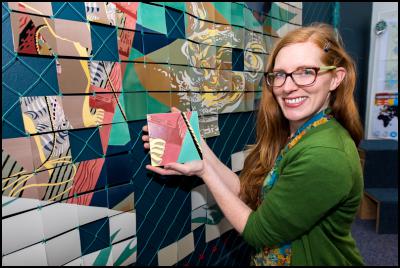Restoration complete on long-lost art treasure
Restoration complete on long-lost art treasure

Restoration has been
completed on a rediscovered significant national mural, and
it is now available for the public to view online (http://bronwyn.co.nz/projects/te-ika-a-akoranga)
and as photographic tiles in a large publicly-viewable glass
cabinet in the JWT offices in the Imperial Building, Lower
Queen Street.
As the reproduction shows, 16 of 414
ceramic tiles that comprise the mural remain missing. The
unveiling is part of an art project titled “Te
Ika-a-Akoranga” (The Fish of Akoranga) by Wellington-based
artist Bronwyn Holloway-Smith, commissioned by independent
public art programme Letting Space.
The
mural is a large-scale illustration of the mythical Māori
tale of Māui fishing up the North Island of New Zealand (Te
Ika-a-Māui). It was originally created in 1961 by leading
New Zealand artist E. Mervyn Taylor to mark the opening of
the Tasman section of the Commonwealth Pacific Cable
(COMPAC), a precursor of today’s Southern Cross Cable. The
present-day fibre-optic cable carries 98% of New Zealand’s
international internet traffic and is allegedly subject to
wholesale mass surveillance, as revealed by Pulitzer
Prize-winning journalist Glenn Greenwald at the Moment of
Truth event at Auckland Town Hall in September
2014.
The COMPAC cable was a major post-World War
Two submarine telecommunications system built between
1961-63 to connect a network of Commonwealth countries. The
more recent Southern Cross Cable’s landing station is
located in the same high-security complex as the now disused
COMPAC landing station.
The work is part of a
commissioned series of projects by independent public art
curators Letting Space for JWT New Zealand, which explores
the relationship between private and public space. For this
commissioned project Holloway-Smith has painstakingly
restored and photographed all the tiles in the Taylor mural.
The reproduction of the mural has been put together
gradually over 2014, like a jigsaw, as the restoration and
digitisation of tiles occurred.
The tiles have been
released online under a Creative Commons copyright license
allowing members of the public, anywhere in the
internet-connected world, to reconstruct their own version
of the mural.
“The COMPAC station was publicly
accessible for many years until approximately 1990, when a
high-security perimeter fence was built around the
complex.” Holloway-Smith has explained. “It seems
appropriate to give part of the work back to the public
considering the mural’s history as a public artwork, the
shifts that have happened in terms of its accessibility, and
its proximity to one of the most important sites in New
Zealand’s communications history”.
The COMPAC
cable reinforced the commonwealth geo-political ties that
were strengthened during World War Two. At the time of
building, the cable cost $100 million, spanning 14,000
miles, and containing 11,000 miles of telephone cable that
linked Scotland, Canada, Hawaii, Fiji, New Zealand, and
Australia. The tale of The Fish of Maui bears a metaphorical
connection with the physical nature of the COMPAC
cable.
Taylor’s mural was installed in the foyer
of the COMPAC landing station in Northcote, Auckland, but
was later removed due to deterioration and thought to be
lost. The mural has recently been rediscovered stacked away
in a disused area of the now defunct COMPAC landing station.
The history of the mural and the Southern Ocean cables is
outlined as part of the art project in a blog here.
‘Te
Ika-a-Akoranga’ is the first work in a series
Holloway-Smith is creating in connection with her PhD
through Massey University College of Creative Arts, where
she is investigating the cultural significance of the
landing sites of NZ’s Southern Cross Cable. It is the
second project in a series commissioned by curators Letting
Space for JWT New Zealand. The first Please Give Generously
by Judy Darragh ran from December 2013 to May
2014.
In Summary:
Work title: Te Ika-a-Akoranga (The Fish of Akoranga)
Artist name: Bronwyn Holloway-Smith
Project begins: May 2014
Full unveiling date: 10 October 2014
Original work: Te Ika-a-Māui, by E. Mervyn Taylor, 1961
Total number of tiles in the mural: 414
Letting Space project page: http://www.lettingspace.org.nz/te-ika-a-akoranga/
ends


 National Youth Theatre: 140 Christchurch Kids Shine In National Youth Theatre’s Historic CATS Premiere
National Youth Theatre: 140 Christchurch Kids Shine In National Youth Theatre’s Historic CATS Premiere NZ Symphony Orchestra: NZSO To Tour Masterworks By Mozart, Beethoven, Haydn And More
NZ Symphony Orchestra: NZSO To Tour Masterworks By Mozart, Beethoven, Haydn And More Journal Of Public Health: Vape Shops Cluster Around Schools
Journal Of Public Health: Vape Shops Cluster Around Schools Timaru District Council: Aigantighe Art Gallery Hosts An Iconic Robin White Touring Exhibition
Timaru District Council: Aigantighe Art Gallery Hosts An Iconic Robin White Touring Exhibition Victoria University of Wellington: Dame Winnie Laban Awarded Honorary Doctorate Recognising Achievements For Pasifika
Victoria University of Wellington: Dame Winnie Laban Awarded Honorary Doctorate Recognising Achievements For Pasifika  HESSA: This Isn’t Fair—And It’s Time To Fix It - HESSA Petition Calls For Inclusive Student Sports
HESSA: This Isn’t Fair—And It’s Time To Fix It - HESSA Petition Calls For Inclusive Student Sports